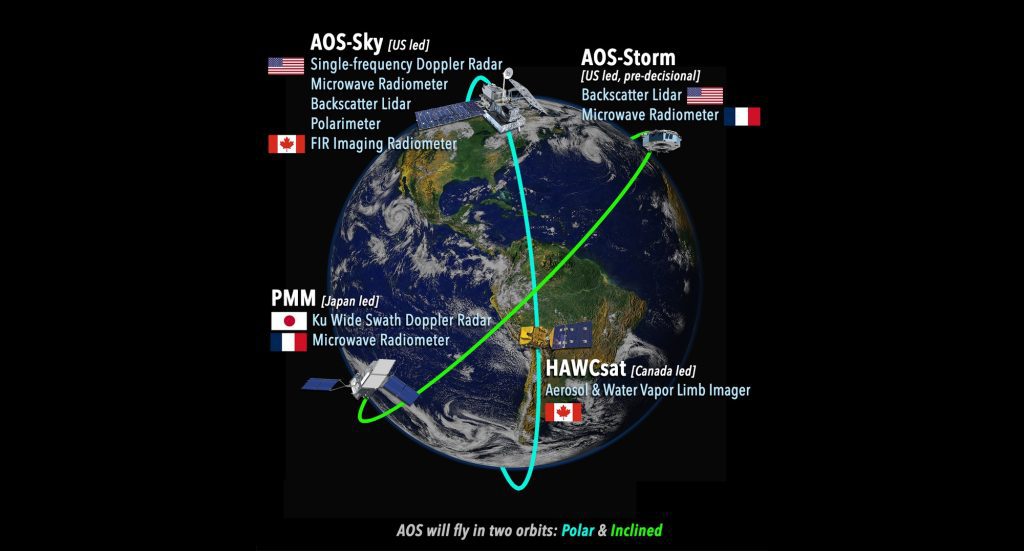WASHINGTON — NASA is updating a major set of Earth science missions, postponing some and depending more on other countries for some missions to decrease costs.
As part of NASA’s budget proposal for fiscal year 2025 was released on March 11, and the agency mentioned that it was reorganizing the Earth System Observatory line of missions. These missions are meant to gather data on specific observations identified in the Earth science decadal survey in 2018.
In December, NASA announced that it was moving forward with four of the missions: Atmosphere Observing System (AOS)-Storm, AOS-Sky, Surface Biology and Geology, and Mass Change, now called GRACE-C. A fifth mission, Surface Deformation and Change, was in an extended study phase.
The budget proposal for fiscal year 2025, however, would bring significant changes to four of the five missions. Only GRACE-C is mostly staying the same in the proposal, which NASA officials attribute to budget constraints on NASA in general, particularly in Earth science.
During an online town hall on March 13 for NASA’s Earth science division, Julie Robinson, deputy director of the division, remarked that the projections for future Earth science budget decreased notably in the 2025 proposal. The proposal anticipates spending about $12.25 billion on Earth science between fiscal years 2025 and 2029, nearly $1.2 billion less than the five-year projection in the 2024 proposal.
“That is the challenge that we had to address in this budget,” she said. “We needed to find some smart ways to bring some of the costs of those missions down.”
Robinson mentioned that NASA has adopted a strategy for the Earth System Observatory called “decouple, partner and compete.” This involves breaking down large missions into several smaller ones, increasing reliance on international partnerships, and opening up some missions to competition instead of being directed missions.
The strategy has the most impact on AOS-Storm and AOS-Sky. AOS-Storm will now involve a partnership with the Japanese space agency JAXA’s Precipitation Measurement Mission. AOS-Sky will change from one large mission to several smaller ones, with at least one being open to competition rather than being developed by NASA.
“You will find that we were able to protect the things that the community was telling us were the most important aspects,” Robinson said. “We essentially went from a tightly coupled architecture to a decoupled architecture.”
This approach saves money through partnerships and by launching smaller missions when they are ready instead of waiting to complete a larger mission. In its fiscal year 2024 budget proposal, NASA had planned to spend nearly $1.3 billion on the two AOS missions between 2024 and 2028, while the 2025 budget proposal anticipates spending just over half of that from 2025 to 2029.
Not everything is preserved with this approach, she acknowledged: a backscatter lidar instrument that was supposed to be part of AOS-Storm had been removed. “That will be a disappointment to parts of the community,” she said.
The Surface Biology and Geology mission has been divided into two parts. One part will carry a thermal infrared radiometer (TIR) and the other will carry a visible and shortwave infrared spectrometer (VSWIR). The TIR will be on a spacecraft provided by the Italian space agency ASI. The VSWIR, which will improve upon the EMIT instrument currently in use on the International Space Station, is expected to be delayed until 2032, and may not launch until four years after the TIR. However, NASA expects the two missions to overlap for joint observations.
NASA is no longer planning to create a Surface Deformation and Change mission. Instead, the NASA-ISRO Synthetic Aperture Radar (NISAR) mission, developed jointly with India’s space agency ISRO, will provide the required data. NISAR is planned to launch later this year.
Many of the specifics about how those changes will be made have not yet been finalized. Robinson mentioned that NASA intends to release a community announcement next week with more details about how it will open part of AOS-Sky to competition.
The Earth science town hall meeting took place immediately after a separate town hall for NASA’s Science Mission Directorate (SMD). This included discussion not only about the changes to the Earth System Observatory, but also about the proposed cancellation of the Geospace Dynamics Constellation, significant funding reductions for the Chandra X-ray Observatory, and uncertainties surrounding Mars Sample Return, among other missions.
“This is a very challenging time, especially for SMD,” noted Nicola Fox, associate administrator for science. “We always want to do more science and there are so many more great things that we would have loved to have done in FY25, but we do have to make tough choices with the resources we are provided.”
“We still have a $7.5 billion portfolio,” she added. “We are thankful for every single penny of that.”









